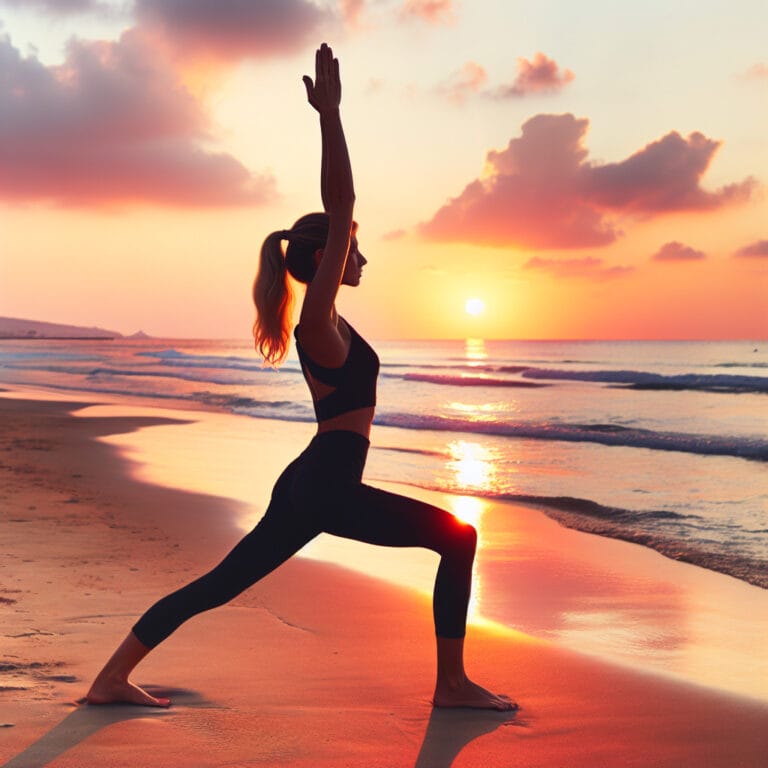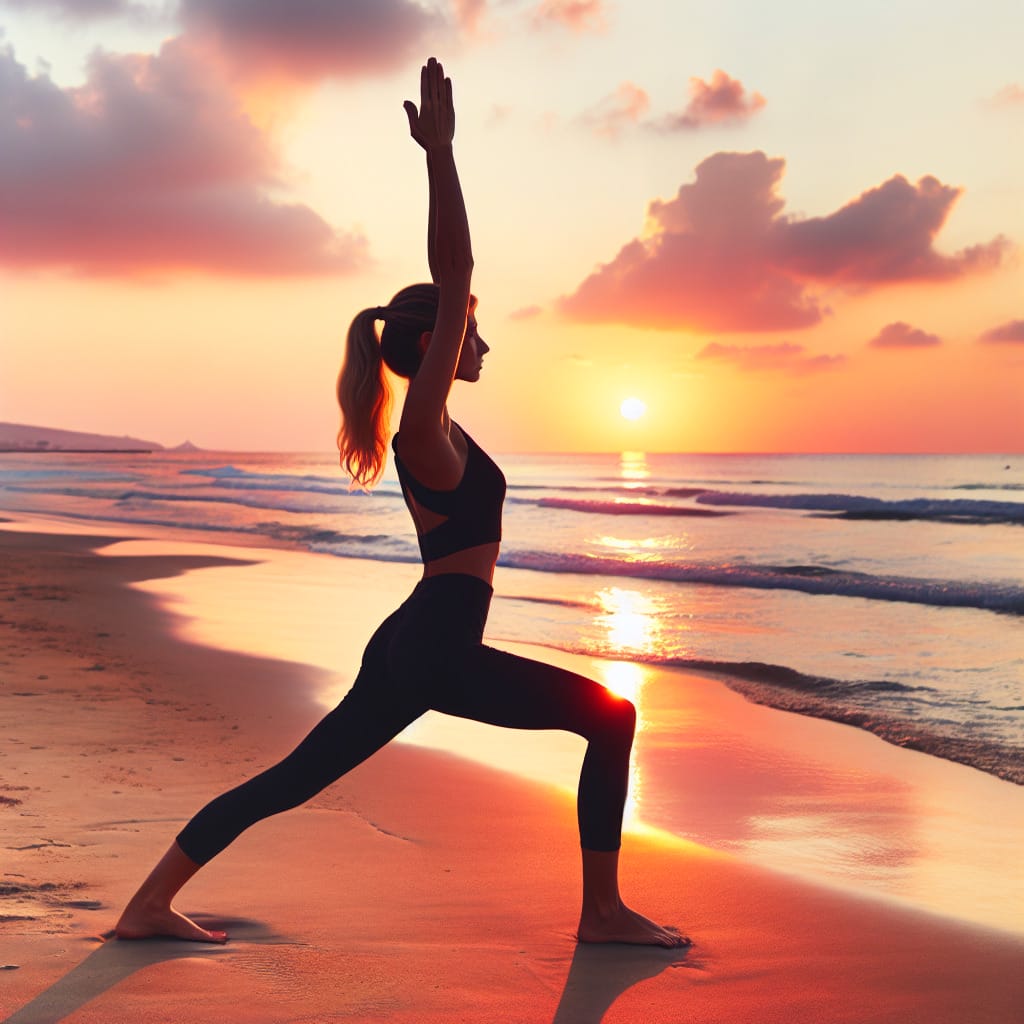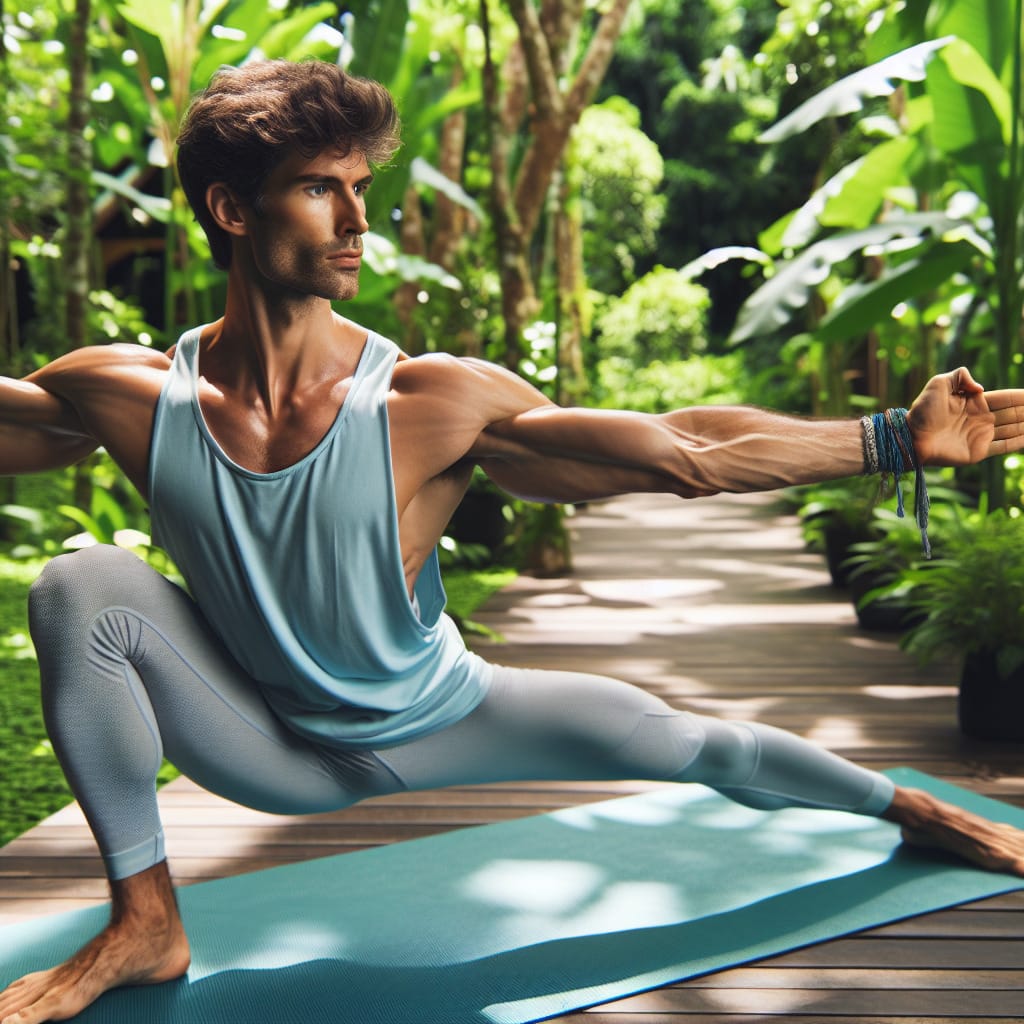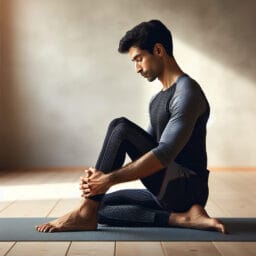
Mastering the Warrior I Pose in Yoga: A Comprehensive Guide
Table of Contents
- Introduction: Understanding Warrior I Pose in Yoga
- The Importance of Warrior I Pose in Yoga
- Step-by-Step Guide to Warrior I Pose
- Common Mistakes in Warrior I Pose and How to Avoid Them
- Advanced Variations of Warrior I Pose
- Conclusion: The Journey Towards Mastering Warrior I Pose
- Frequently Asked Questions
Introduction: Understanding Warrior I Pose in Yoga
Mastering the Warrior I pose, a foundational standing yoga pose in many sequences, brings with it an array of benefits that extend beyond the mat. Apart from building strength in your legs and core, it helps build focus and power, making it much more than a physical workout. The act of aligning your front knee directly over your ankle while keeping your back foot flat on the mat stretches out hip flexors effectively. This becomes especially beneficial for those who spend significant time seated as it can help alleviate lower back discomfort. As you draw your shoulder blades down and lift your chest towards the sky with arms straight ahead or overhead, you engage upper body muscles and open up the heart center- promoting better posture over time. Also noteworthy is how placing emphasis on keeping hips facing forward aids in achieving proper hip alignment; a crucial aspect in many standing poses like Warrior II and Chair pose as well. A flurry of variations exists to amplify these benefits further or make this pose accessible for beginners; From bending the back heel to adjusting the distance between feet or simply modifying arm position- each variation enabling practitioners to go at their own pace while reaping maximum advantages from this powerful pose.

The Importance of Warrior I Pose in Yoga
Delving deeper into the multitude of benefits, Warrior I pose serves as an invaluable addition to any yoga routine. As a standing yoga pose, it works on the entire body – engaging upper body muscles and stretching hip flexors. When you align your front knee over your ankle, keep the back foot flat on the mat while ensuring your hips are facing forward, you’re not just working on lower body strength but also promoting better posture by opening up the heart center. This foundational pose stretches out tight muscles in your legs and core which often bear the brunt of prolonged sitting periods. Simultaneously enhancing focus and power through this practice can offer immense mental benefits as well; making it a holistic mind-body workout that goes beyond merely building strength.
Step-by-Step Guide to Warrior I Pose
The Warrior I pose, with its multitude of variations, serves as a cornerstone for both beginners and advanced practitioners in yoga. The foundational pose stretches the hip flexors, upper body muscles and legs core effectively while building strength which is particularly beneficial for those dealing with lower back discomfort from prolonged seating periods. As you transition into the pose, pressing your back heel onto the mat and aligning your front knee directly over your ankle is paramount to maximizing benefits. This alignment aids in opening up the chest as you lift it towards the sky with arms straight overhead or placed forward – a position that engages shoulder blades promoting better posture over time. A unique aspect about Warrior I Pose is that it not only enhances focus and power but also paves way for mastering other standing poses like Warrior II and Chair pose through its emphasis on proper hip alignment. For added challenge, advanced yogis can experiment by bending the back heel or adjusting foot forward distance between feet without compromising on form. Remember to keep toes pointing forward and hips facing forward during execution to maintain central line balance throughout this full-body workout.
| Title | Step-by-Step Guide to Warrior I Pose |
|---|---|
| Target Audience | Beginners and Advanced Yoga Practitioners |
| Benefits | Stretches hip flexors, upper body muscles and legs core, builds strength, enhances focus and power, promotes better posture, paves way for mastering other standing poses |
| Beneficial For | Individuals with lower back discomfort from prolonged seating periods |
| Key Execution Points | Pressing back heel onto mat, aligning front knee over ankle, lifting chest towards sky with arms straight overhead or placed forward, keeping toes and hips pointing forward |
| Advanced Variations | Bending the back heel, adjusting foot forward distance between feet |
Common Mistakes in Warrior I Pose and How to Avoid Them
Undoubtedly, mastery of the Warrior I pose holds an undeniable relevance in the realm of yoga, being a significant cornerstone that helps build focus and power. This robust standing yoga pose stretches out hip flexors and strengthens your legs’ core while maintaining a straight alignment from front knee to back heel. The pose demands mindfulness, as one wrong move could lead to common mistakes such as letting your front knee bend past the toes or misaligning hips – these can be corrected by ensuring your feet are slightly wider than hip-width apart with toes pointed forward. Notably, consistent practice plays a pivotal role in achieving proper form; it aids in establishing stability in the standing leg while keeping chest lifted and arms raised overhead. An interesting variation for advanced practitioners is bending the back heel or adjusting foot forward distance without compromising on form. As you navigate through this transformative journey called Yoga, remember that each Warrior pose serves as an essential stepping stone towards self-discovery and wellness.
Advanced Variations of Warrior I Pose
Diving deeper into the Warrior I pose in yoga reveals a plethora of advanced variations that can further enhance strength, flexibility, and focus. Experienced practitioners often experiment with bending the back heel or adjusting foot forward distance – while these adjustments increase challenge level, it’s crucial to maintain correct form like keeping toes pointing forward and ensuring hips facing forward. These modifications not only stretch hip flexors more intensely but also engage arms straight overhead or placed forward, necessitating shoulder blades to draw down – this activates your upper body muscles effectively. However, safety should always be paramount; hence practicing under guidance ensures you do not extend your front knee past your toes or compromise on hip alignment inadvertently- common errors when attempting advanced variations. As you gradually progress in mastering this foundational standing yoga pose as well as other warrior poses like Warrior II and Chair pose; remember every step strengthens lower body muscles, builds focus power and keeps the journey towards overall wellness alive.

Conclusion: The Journey Towards Mastering Warrior I Pose
Delving into the transformative world of yoga unveils an array of poses, each with its unique set of benefits. Among them stands the Warrior I pose – a cornerstone in yoga practice that not only helps build focus power but also essential for mastering other standing poses including Warrior II and Chair pose. As you step your left foot back and press your back heel onto the mat, aligning your front knee over your ankle, you’re engaging muscles from head to toe. This foundational pose stretches hip flexors – providing relief for lower back discomfort often experienced due to prolonged seating periods. The arms extended overhead or forward engages shoulder blades, enhancing upper body strength while keeping the chest lifted promotes better posture. Maintaining toes pointing forward is key in ensuring proper hip alignment; a pivotal aspect that lays the foundation for more advanced variations like bending back heel or adjusting foot forward distance without compromising on form. The journey towards perfecting this robust standing yoga pose may seem daunting initially; however, consistent practice paves way for achieving correct form and reaping maximum benefits from this full-body workout which can lead to overall wellness.
Frequently Asked Questions
Q: What is the Warrior I Pose in Yoga?
A: Warrior I Pose, also known as Virabhadrasana I, is a foundational standing pose in yoga. It requires strength, balance, and focus.
Q: What is the historical and cultural significance of the Warrior I Pose?
A: Named after Virabhadra, a fierce warrior in Hindu mythology, the pose symbolizes strength and victory. The Warrior poses honor the spiritual warrior’s battle with the universal enemy, ignorance.
Q: What are the physical and mental benefits of mastering the Warrior I Pose?
A: Warrior I Pose strengthens your legs, back and shoulders, opens your hips and chest, and enhances your focus and balance. It also has emotional and spiritual benefits, such as boosting self-confidence and courage.
Q: How does Warrior I Pose contribute to overall yoga practice?
A: It’s an integral part of many yoga sequences and contributes to developing a strong foundation. It also enhances flexibility, balance, and alignment, which are essential for more advanced yoga poses.
Q: How do I properly execute the Warrior I Pose?
A: Detailed steps need to be followed like maintaining proper posture, focusing on front knee and back foot placement, and keeping the shoulder blades drawn in. Consistent practice helps in mastering the pose.
Q: What are some common mistakes in Warrior I Pose and how can they be avoided?
A: Common mistakes include incorrect hip alignment and footing. It’s important for your hips to face forward with the front heel grounded. Regular and conscious practice can help correct these mistakes.
Q: Are there advanced variations of Warrior I Pose?
A: Yes, there are advanced variations of Warrior I Pose that experienced practitioners can explore to enhance their strength, flexibility, and focus. It’s recommended to practice these variations under guidance and take necessary safety precautions.
Q: Why is mastering Warrior I Pose important?
A: Mastering Warrior I Pose helps lay a solid foundation for your yoga practice. It aids in building strength, improving balance and focus, boosting self-confidence, and bringing a sense of courage and victory. It also paves the way for executing more advanced poses and variations.



